HIT CHANNEL EXCLUSIVE INTERVIEW: January 2015. We had the great honour to talk with one of the greatest drummers of all time: Michael Shrieve. He is best known as a member of Santana and played on their first eight albums. As a 20-year-old drummer, he played a mind-blowing drum solo in “Soul Sacriface” during Santana’s performance at the Woodstock Festival in 1969. After Santana, he was a member of Go (with Stomu Yamashta, Steve Winwood, Klaus Schulze and Al Di Meola), Novo Combo, Hagar Schon Aaronson Shrieve (with Sammy Hagar, Neal Schon and Kenny Aaronson) and Abraxas Pool. He has also played with Mick Jagger, The Rolling Stones, George Harrison, Pete Townshend, Todd Rundgren, John McLaughlin, Jaco Pastorius, Ringo Starr, Pat Travers and Roger Hodgson. He is current active with his band, Spellbinder. Read below the very interesting things he told us:
 What are the current projects you are involved in?
What are the current projects you are involved in?
Today, I spent all day working on my band’s new recording and that band is called Michael Shrieve’s Spellbinder. It is with Seattle-based musicians. We’ve played together for about 4-5 years and we have one CD out and we are close to finish up a new one. It’s a band that I play a lot within Seattle area. We’ve had a weekly residency at a club for 4 years. We play once a week. That’s one record that I am excited to finish up and get out. I have another record that I put out two months ago: a project called Trilon and it is with a very interesting group of musicians. A had a very good friend of mine, Brian Siskind, do a remix of all the tracks on Trilon and I’m very happy with the way it came out. Both of these are instrumental records. The other thing is I have finished a record called “Drums of Compassion, a record I’ve been working on for too many years but it’s a very important record for me. I play 16 drums set up in a semi-circle. One night I came home, some years ago after listening to bands. I like to go out and hear music. I’d come home at 2 in the morning and I’m thinking: “What kind of music would I like to listen to at this time?”And it’s usually not heavy music. I thought: “What kind of record would be good for me as a drummer that I would love to listen to at 2 in the morning?” And so this is what the record sounds like. I started it with a synthesist by the name of Jeff Greinke and then I added other performers like Jack De Johnette (ed: Miles Davis -drums), Airto Moreira (ed: Miles Davis –Percussions), Zakir Hussein (ed: Shakti –tabla), Trey Gunn (ed: King Crimson –Chapman stick) and Amon Tobin (ed: Brazilian composer). This is a very important record for me. It will be out this year as well. And then of course we are continuing with the original Santana band. We are recording together for the first time since the early ‘70s. We have recorded 9 tracks and we are getting together in April for a couple of weeks and we will be able to finish that up as well. I think that it sounds great. So, those are the projects that I’m working on right now.
Are you happy with the reunion of the classic Santana line-up after 40 years?
It’s beautiful. It’s like putting on a pair of old jeans.
Do you have clear memories of the Woodstock Festival?
Yes, pretty much. I lived an amazing experience.
How spontaneous was your drum solo in “Soul Sacrifice” at Woodstock?
Completely spontaneous. Nothing was planned. It was completely improvised.
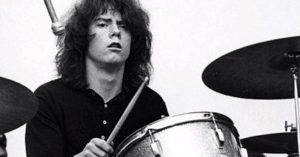 What was your reaction when you watched the “Woodstock” film for the first time?
What was your reaction when you watched the “Woodstock” film for the first time?
When I saw myself on the screen, split up in six pieces, I had two reactions: 1) I wanted to stand up and say: “That’s me! That’s me!” And the other one, I wanted to just sit down in my seat and kind of hide. And do you know an interesting thing about that? Martin Scorsese edited that. He did all that stuff during my solo.
Why you decided to re-record the drum parts in “Song of The Wind” (from the “Caravanserai” album -1972) after Carlos Santana and Neal Schon recorded their guitar parts?
They both played beautifully and they were very happy putting their parts. Traditionally, the way it works, is that you get what they call the basic tracks, which is always the drums and the bass and that’s that. Then, you don’t need to do any drums. But the guitar players or the singer or somebody could punch in and keep making their solo better. And at the end of the evening, in the studio they recorded such beautiful stuff that I thought: “Wow, I should have played with them”. And I was determined to do that. That’s what happened to me. But you can’t do that. Back in those days it was too difficult to do that without Pro-Tools, without computers. If you mess up the basic tracks, if you re-record the drums and mess it up, you can ruin the whole track and keep doing it over and over on the drum set. So, I said to the engineer that after everybody left: “I am going to work on this all night long. I am going to practice the way I want to play it with what they have done now Carlos Santana and Neal Schon. So, be here tomorrow early and let’s do it”. I didn’t tell any in the band. The engineer was still frightened, because if I mess it up they would probably blame him for it. They should blame me. He said: “Please Michael, don’t do this”. I just said: “Be here early tomorrow. I will tell you at what time”. I worked all night long and I came back and I said: “Roll the tape” and I did it. I was able to perform that song with what they had worked on after the basic track is done. And it turned out great.
How important was the contribution of Bill Graham (legendary promoter) to Santana?
It’s immeasurable the value of Bill Graham to Santana. He took us on like a father. He got us at Woodstock and he always loved the band. He was always a music fan of the band. He loved Carlos and he loved the band. If it wasn’t for him, we wouldn’t have been at Woodstock and many other things. He was like a brother or like a father to us. So, all of us are incredibly grateful to Bill Graham and what he did for the band.
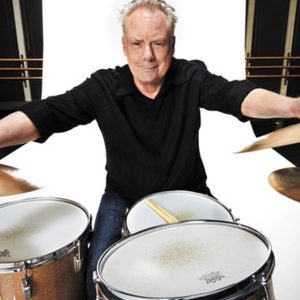 Do you feel lucky that you shared the stage with Miles Davis?
Do you feel lucky that you shared the stage with Miles Davis?
We played a show at Tanglewood together. It was a great show. It was a year after Woodstock (ed: 8/18/1970). We played a double bill: Miles Davis and Santana. I think this one is one of our best shows ever. Well, you know, it was incredible to play with him. Of course, I was a huge Miles Davis fan and so was Carlos. For us, it was very important that we were playing on the same bill. We had something to deliver and we did. We used to play at The Fillmore and Miles would just come down and see us as well. We were big fans of Miles and Miles was a big fan of the band, which was incredible. He was the man. I think we played an amazing show that night. Actually, I think we should put that record out. I am gonna look into that.
Your drum solo in “Soul Sacrifice” at Tanglewood is even better than Woodstock.
I think you are right. That was better and so was one that we did in Japan in 1973 for the “Lotus” record. That was better, too. Much better. But, I know this: It doesn’t matter. The movie (ed: “Woodstock”) shows the way I looked, and the way everybody in the band and the audience looked and it was a powerful moment. But I have drum solos better than my Woodstock solo. And fortunately, they are available to public on Youtube: Montreux Festival 1971, Tanglewood 1970 and then the “Lotus” album from Japan. Those three are available to public, there are all much better than Woodstock. But I know that that it doesn’t matter!
You got an offer to join Jefferson Airplane. Could you imagine yourself as a member of Jefferson Airplane?
Well, I could. It was pretty exciting to me. They were a big band and I was a boy at high school. They were one of the most important bands of the San Francisco music scene, of course. I must say that in the week we played together, it never worked out. But we always remained friends, and I am so glad that it work out with Santana, we played at Woodstock and we created some great music together. That was my band.
You spent two weeks with your hero Elvin Jones (John Coltrane, Charles Mingus, Miles Davis –drums) on holiday in Greece. Did you have a good time there?
Oh yes. I did, although –I will tell you the truth- Elvin and his wife, Keiko, used to go yearly after the European tour to… I am sorry I forget the specific place. But it wasn’t so Greece. It was just a hotel with a bunch of Germans on vacation. It wasn’t my idea of Greece. It was kind of weird. I did stay there for two weeks because I interviewed Elvin for a book I was working on about his life at that time. But I left for 3-4 days, got on a bus in the mountains with chickens and everything on the bus (laughs). Seriously. And then I went to an island and when I arrived there, I had no place to stay and I was walking and looking for a place to stay. I couldn’t find one. I loved being on the beach. Every place I went into, every café to ask about a place to stay was playing different music. And I said: “Wow, this is music that I have never heard but it’s so perfect”. And it was this singer, Cesaria Evora. She was perfectly beautiful. They were playing it in every place I went into. So, yes I had a great time being there.
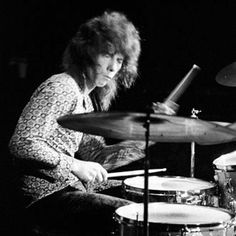 Was it a challenge to form Go with Yamashta, Schulze and Winwood after a very successful career with Santana?
Was it a challenge to form Go with Yamashta, Schulze and Winwood after a very successful career with Santana?
Oh, no. I’m the one that pursued Stomu Yamashta. For a year, I looked for him, because I loved what he was doing in the world of percussion. It was a big touring year for Santana, we had over 250 dates to do. On the last day of the tour, I found out that Stomu Yamashta was staying at the same hotel as me, in Rome. We set up a meeting. I wanted to do a record with him. Mind you, I was looking for him for a year. I wanted to do an avant-garde percussion thing. So, when I met him, he was in the process of putting together his vision of combining pop music with other things. So, he had Winwood, he had Klaus Schulze … So, that’s what I did. I appreciate all the time that I spent with Stomu Yamashta.
Were you shocked by what happened at the 1969 Altamont Free Concert (during the performance by the Rolling Stones, Meredith Hunter, an 18-year-old African-American, was stabbed to death by a Hells Angels member)?
Yes, of course. That was a kind of nightmare. That changed the game there. It was frightening. I got out of there as soon as I could. We even chose not to be in the movie (ed: “Gimme Shelter”).
You are in the movie talking to Jerry Garcia and Phil Lesh (of the Grateful Dead).
Correct. Yeah, I was getting out of there as they were coming in. They couldn’t believe that the Hells Angels were beating everybody up, as you can see in the film. The only thing I wanted to do, was get out of there. It was so sick. They were hurting people. You can see the Hells Angels on stage, their dark souls and stuff like this. I wanted to get out of there and Gregg Rolie (ed: Santana –keyboards, vocals) too. It wasn’t set up well. That was a dark night.
 Was it an interesting experience to record Mick Jagger’s “She’s the Boss” album (1985) with Mick and Jeff Beck?
Was it an interesting experience to record Mick Jagger’s “She’s the Boss” album (1985) with Mick and Jeff Beck?
Yes, absolutely. There is one track that I am on. I played on a lot of tracks but I only ended up on one track. It was Mick’s first solo record. He was trying a lot of things and we recorded that in Nassau, Bahamas. I stayed with Mick at Chris Blackwell’s –the founder of Island Record- house, since we met there. We knew each other in New York and London and we were friends. So, I ended up in that track and there was also Jeff Beck, Pete Townshend (The Who), Herbie Hancock, many people… Yes, I enjoyed it very much. I always enjoyed the time that I spent with Mick Jagger. I find him a fascinating, intelligent and hard-working person. He’s truly hard-working. Look at him in concerts, still.
Do you remember the crazy after midnight session you did with Jaco Pastorius?
Yes, I do. How do you know about that? Yes, that was quite a night. That night I was there after Mick Jagger’s recording in The Bahamas and we were mixing the record at The Power Station in New York City with Nile Rodgers, Mick and me. And then Jaco Pastorius come up with war paint on and says: “Michael Shrieve, I’m calling all the guys! We are recording downstairs”. Nile and Mick looked at him, but they knew him. Everybody knew that Jaco was a very great bass player but he was kind of crazy. I went down there and I did record. I never heard that recording but it was interesting. I can’t say what it was. I never heard it.
You did a very interesting interview with Neil Peart (Rush). Were you flattered when Neil Peart told you that you are one of his influences as a drummer?
Oh, yeah! In fact I was very surprised. He came in and he told me that he used to play “Soul Sacrifice” in a band he had and also that he was a big Grateful Dead guy too. I was very impressed with him. He was very knowledgeable, very open, curious and very intelligent. He has a lust for life that I very much admire. He was very inspiring to me. We got on very well, although we haven’t been in touch since. I would like to get back in touch with him. I enjoyed it very much.
 How did you feel when you played “With A Little Help From My Friends” on Ringo Starr’s drum kit during a Ringo show in Seattle?
How did you feel when you played “With A Little Help From My Friends” on Ringo Starr’s drum kit during a Ringo show in Seattle?
(Laughs) Well, that’s something. You play on Ringo’s kit with Ringo and he’s singing, not playing and Gregg Bissonette (ed: Ringo Starr, David Lee Roth –drums) was playing. And Ringo turns around and say: “Don’t break my drums”. It was special. But it was also interesting to play with the other members of his band. That was a thrill. The next time I saw Ringo was because my friend Gregg Rolie from Santana was playing with him and Todd Rundgren who I worked with, as well- I am sitting in the audience and I see Ringo playing “Evil Ways” and “Oye Como Va” or something like that and I flashed back in time to me, being with my parents watching “The Ed Sullivan Show”, watching Ringo. And now I am here and I watch Ringo play a song that I recorded originally. It was like a time travel. It was kind of surreal. “Surreal” is the correct word. It was really surreal. You just don’t know what life is gonna present you.
How did it happen to record some demos with Pete Townshend (The Who)?
When I lived in New York in the ‘80s, we used to hang out a lot, going to clubs and stuff like that. He used to come and see the band that I had called Novo Combo. He liked the band and we enjoyed each other’s company. He just had an idea and he wanted to put down some songs in the studio. So, he called me up. I think there wasn’t anybody else, just the two of us. But man, he was at Atlantic Studios and Jimmy Miller, the famous producer (ed: Rolling Stones) was recording it. And up there, there were drums, everything was set up, and Pete had a quad stereo and an incredible amplifier set up. And I realized that playing with Pete –I have played with a lot of people- was super powerful. You play with a lot of people, but when you are in a room with Pete, you realize that there was a real power emitted from him. You just know it from the sound and the way he played during the jam. I was thrilled. Of course, I was thrilled and proud to be there. At least, we did demos for his next record which was called “All the Best Cowboys Have Chinese Eyes” (1982).
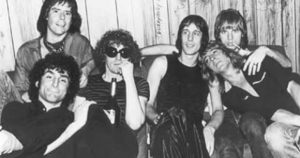 Can you tell us a few words about the “John Anderson For President” tour with my hero Todd Rundgren, Ian Hunter (Mott the Hoople) and Mick Ronson (David Bowie)?
Can you tell us a few words about the “John Anderson For President” tour with my hero Todd Rundgren, Ian Hunter (Mott the Hoople) and Mick Ronson (David Bowie)?
Todd Rundgren is your hero? (laughs) Yes, he’s amazing. Oh, I had a great time doing that. It was a real pleasure and a big honour to be with Todd, Mick Ronson, Ian Hunter and Stephen Dees from my band Novo Combo. It was great. We did it at a good time for a distinct purpose, which is “John Anderson for President” but it got me to know these guys more: Todd, Ian and Mick. I had fun playing with these guys. It was a great experience for me to play that kind of music. That was good too.
Did you meet Jim Morrison and Eric Clapton when you stayed at a hotel with Jefferson Airplane?
I did. I met Jim Morrison and then Eric Clapton. I was just a kid. And then, of course, I got to know Eric better, his jamming with Santana and stuff and then I met him over the years. But Jim Morrison I met just that one time. That was before Jim Morrison’s name become mythical. He was just a singer in another band.
You knew almost everybody. Who is the most talented musician you’ve seen in your life?
I don’t think like that. Everybody is unique. There are so many people that I admire and I respect for their particular skills. I mean, Carlos is a person that I respect in so many ways. Firstly, because he endured and got on so long with quality music and also with his choices of notes. And also Todd Rundgren and Pete Townshend. Who else? When you get to work with different people like Roger Hodgson from Supertramp is something special. When he started playing the piano I said: “Wow, what a sound!”That Wurlitzer sound! It’s difficult for to me to put a meter on who is the most talented, because everybody brings such a different feeling. For instance, if I had worked with someone like Prince, I might say Prince because he can do everything. Todd Rundgren is a little bit like that. He can do a lot, a lot of things. Not just a few things. So, I don’t know if I can name one person. There are so many of them that I got to know. They influence you when you are around them and that’s perfect.
Are you happy with the triumphant return of the vinyl?
Yes, I’m very excited about that. I want to get back into it myself. I need to buy myself a turntable. People are sending me re-releases of Santana stuff and other records too: jazz stuff. I definitely want to get myself back and listen to music like I used to. The only problem right now is that life takes over and I don’t listen to music like I used to listen to music. What I want to do and why I am excited about the vinyl and the re-releases, is that all are of such a high quality level. So, the music can get into your body and moves you like it used to do when you were a kid. And it amazes you when it happens again.
Do you still have the drum kit you used at Woodstock?
Yes, I do.
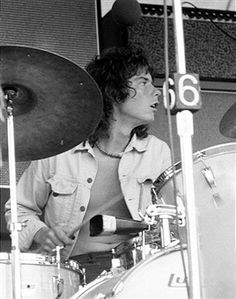 Can you tell us a few words about Jerry Garcia. You got to know him.
Can you tell us a few words about Jerry Garcia. You got to know him.
Yes. You know, I was never great friends with Jerry Garcia but we definitely knew each other and we were around and saw each other. He was always very joyful and generous person. He loved to play the guitar, he loved to make music. I didn’t know him intimately like my friend Mickey Hart (ed: Grateful Dead –drums) or other people. Obviously, he had his own problems going on, but he was always very generous, very joyful and very open.
Earlier today, I did an interview with Country Joe McDonald (ed: Country Joe and the Fish) and I told him that I will talk with you later and he told me to say “hello” to you and that you are a great musician.
Oh, wow!! You are very busy. Let me say that I met Joe at a post Woodstock thing and we never really met each other prior to that. He is so very kind with the things that he said. He’s not like people think he is. He’s a really great guy. I liked him, actually. It’s a pleasure for me to hear his kind words. Anyway, thank you. I appreciate this.
A huge “THANK YOU” to Michael Shrieve for his time.
Michael Shrieve Official Website: www.michaelshrieve.com
Michael Shrieve’s Spellbinder Facebook page: https://www.facebook.com/pages/Michael-Shrieves-Spellbinder/16840285790


